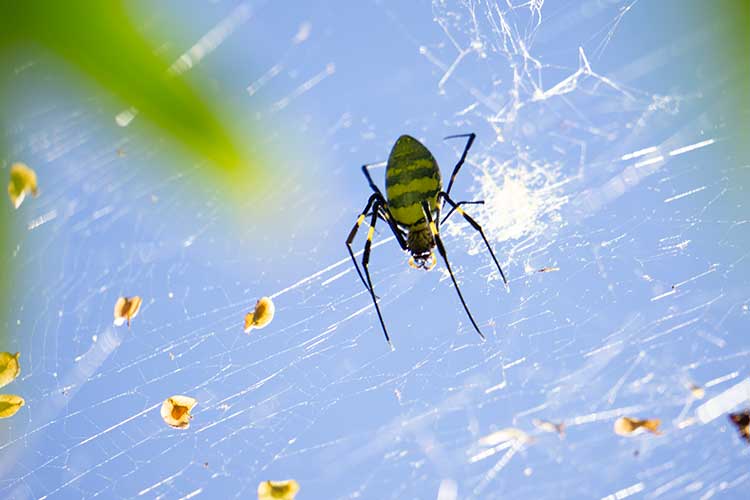
Since first making their appearance in Georgia in 2014, Joro spiders have steadily expanded their range in Georgia, and now — just in time for Halloween — the spooky-looking species has reached the University of Georgia Research and Education Garden on the UGA Griffin campus.
Native to Japan and China, Joro spiders are believed to have made the trek overseas by hitching a ride in a shipping container. The striking arachnid spotted at UGA-Griffin is thought to be the first documented sighting of the species in Spalding County. So far, sightings have been limited to the northern region of the state. Spalding County is located about 40 miles north of the Georgia fall line, which separates the Piedmont region of the state from the Coastal Plain.
Entomologist Dan Suiter, a professor in the UGA College of Agricultural and Environmental Sciences, confirmed the species’ identity after it was discovered by Alyssa NeSmith, a horticultural assistant with the Research and Education Garden.
“We think this may be the first report of one in Spalding County,” Suiter said. “There have been positive reports in surrounding counties such as Henry and Pike, but as far as we know there have not been any in Spalding.”
On jorowatch.org, UGA entomologists are tracking sightings of the spider to help determine how they are moving throughout the state. Spider spotters who think they have found a Joro can upload a photo and location information on the website where the species will be confirmed by researchers. The spiders are similar in appearance to the golden orb weaver, a spider native to Georgia, which is why the identification must be made by entomologists trained to correctly identify different species of arachnid. A map on the website shows the counties where Joro sightings have been confirmed. Spalding County is the 47th county in Georgia to host the eight-legged creature.
The Joro is considered a large orb-weaver spider and is primarily seen in September and October as they reach maturity.
“I just think it is really cool these spiders are reaching their maturity around Halloween,” said Suiter, noting their large golden webs add a type of natural spooky décor for the season.
Male and female Joro spiders differ greatly in size, with the males dwarfed by the larger, more colorful females. Male Joros are approximately 0.25 inches long and brown with two yellow stripes on each side of their abdomen and a brown stripe in the middle. Adult female Joro spiders have a yellow abdomen with broad blue-green bands on the back side and yellow and red markings on the underside that can grow up to 1.25 inches long. They also have long black legs with yellow bands that add to the females’ impressive size.
The spider spotted in the Research and Education Garden is a female who will be preparing to lay an egg sac between now and November. These egg sacs are made of a dense white silk and contain between 400 to 500 eggs. Female Joros often attach their egg sacs to leaves, tree bark or flat surfaces, but they can also attach them to potted plants or cars, which helps explain their spread throughout the state and into the upstate and midland regions of South Carolina.
After surviving the winter, the eggs will hatch in the spring and the tiny babies have two ways they can move, either by ballooning or by hitching a ride on items moved from one place to another. Joros that use ballooning — spinning tiny parachutes of spider silk that are picked up by the wind and blown to a new location — can move about 10 miles a year. The range of Joro spiders transported on moveable surfaces is virtually limitless.
Researchers are currently evaluating the effect the species will have on local ecology, but it is too soon to fully understand their impact. The good news is they pose no danger to humans and pets. In even better news, Joros are one of very few natural predators of stink bugs, one of the South’s most notorious agricultural nuisances, as well as other insects that fly into their webs, such as moths, flies and mosquitos.
“They are harmless to humans and eat other pest insects,” said Suiter. “There is nothing to be afraid of, and it looks like they are here to stay.”
Arachnid enthusiasts who would like to get a glimpse of the Joro spider can visit the UGA Research and Education Garden at 129 W. Ellis Road in Griffin. The garden is open to the public Monday through Friday from 8 a.m. to 5 p.m. The garden will also be open on Sunday, Oct. 23, and Sunday, Oct.r 30, from 1 to 4 p.m. Once in the garden, follow the path on the left-hand side to a small pond, where the Griffin Joro was last spotted perched in its web suspended above the pond.
For more information on Joro spiders and how to report a sighting, visit jorowatch.org.
